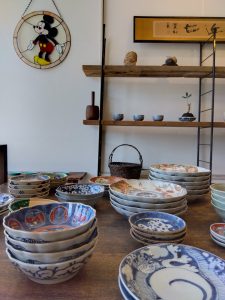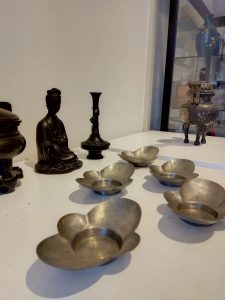寒い日にはおでんがいいですね(愛知県名古屋市千種区姫池通 骨董買取 古美術風光舎)
2023.11.14
皆さまこんにちは。スタッフT でございます。
朝晩はすっかり冷え込み、いよいよ冬がやって来ますね。もう少し秋を楽しみたいなと思うのですが、季節は待ってくれませんね。それならばと、着々と冬支度始めた今日この頃です。

寒い季節には、あったかいおでんが食べたくなります。ここ数日でぐっと寒くなりましたので、私も今日はおでんを仕込んでまいりました。おでんはいまやコンビニでも気軽に買うこともできる、日本国民にとって冬の定番メニューのひとつ。でも実は、味つけや具材に地域差がありますね。
おでんのルーツは室町時代に流行した「豆腐田楽」。その後、江戸時代にはファストフードとして江戸庶民に愛され、やがて煮込みおでんへと進化。さらに屋台や居酒屋で食べる料理から家庭で食べる料理へと変化し、おでんは現代の定番料理へ。時代とともに進化を遂げてきました。
おでんの語源は、拍子木型に切った豆腐に竹串を打って焼いた「田楽」だそうで、この「田楽」の女房言葉と言われています。女房言葉とは、宮中などに仕える女房が使用した隠語で、田楽に「お」をつけて丁寧にし、楽を省略して「おでん」となったようです。
豆腐を串に刺して焼き、辛みそをつけた「焼き田楽」、こんにゃくを串に刺し、みそをつけて食べる「こんにゃく田楽」が人気料理となります。そして明治期には汁気が多いおでんに進化し、それが大正期に関西に伝わったようです。東京の料理人によって大阪に持ち込まれた煮込みおでんは、みそだれのおでん(田楽)と区別して「関東煮」(かんとうだき、かんとだき)と呼ばれました。
味つけにしてもおでん種にしても変化の少ないと思われがちな「おでん」ですが、おなじみの具から変わり種まで、さまざまな食材の味を楽しめますね。
おでんの具材の定番といえば何を思い浮かべるでしょう。「大根」「たまご」「牛すじ」「はんぺん」などの練り物でしょうか。定番以外で、私がお気に入りなのは「玉ねぎ」と「卵焼き」です。
玉ねぎは丸ごと具にします。皮をむいてへたを落とし、十字に切込みを入れた玉ねぎをレンジで加熱した後、おでんのだしを別の鍋にとり、煮込みます。柔らかくなったら他の具材とともに味を浸み込ませれば完成です。「卵焼き」は煮卵が苦手だからという理由ですが、だしが浸み込んでふわふわでおいしいですよ。
一般的なおでんは、鰹節や昆布でとった出汁をベースに味付けされますが、名古屋のおでんは一味違います。名古屋グルメと言えば味噌をふんだんに使用した料理が有名ですが、なんとおでんも味噌ベース。味噌をベースに甘めの出汁で煮込まれた「味噌おでん」は、別名「味噌どて」とも呼ばれており、名古屋だけではなく愛知県全域で愛されています。
「味噌おでん」は本来、大阪を中心に食べられていた牛すじ煮込みである「どて焼き」が変化し、現在の形になったと考えられています。その説を裏付けるように名古屋で「どて焼き」は「どて煮」と呼ばれ、それぞれ区別されていますが、基本的な味付けは同じ。提供するお店によっては「味噌おでん」も「どて煮」も区別していない場合もあるようですね。
味の浸みこんだ「おでん」をあてに一本つけたくなりました。ではでは、また。

Hello everyone. This is Staff T.
The mornings and evenings are getting colder, and winter is finally here. I would like to enjoy autumn a little more, but the season doesn’t wait for me. So, I have started to prepare for winter.
The cold season makes me want to eat warm oden. It has gotten much colder in the past few days, so I prepared some oden today. Oden is now one of the staple winter dishes for the Japanese people, and can be easily purchased at convenience stores. But in fact, there are regional differences in seasoning and ingredients.
Oden has its roots in “tofu dengaku,” which became popular in the Muromachi period (1333-1573). Later, during the Edo period, it was loved by the Edo common people as a fast food, and eventually evolved into stewed oden. Oden has further evolved from a food served at yatai (food stalls) and izakaya (Japanese style pubs) to a home-style dish, and has become a staple of today’s cuisine. Oden has evolved with the times.
The word “oden” is said to have originated from “dengaku,” which is tofu cut in the shape of a spur and grilled on a bamboo skewer, and is said to be a wives’ language. Wives’ language was a cloak used by wives serving in the imperial court, etc. It seems that “dengaku” was made polite by adding “o” and omitting “raku” to become “oden” (oden).
Yaki-dengaku” (grilled tofu skewered and grilled with spicy miso) and “konnyaku-dengaku” (konnyaku skewered with konnyaku and dipped in miso) became popular dishes. In the Meiji period (1868-1912), oden evolved into oden with a lot of liquid, which was introduced to the Kansai region in the Taisho period (1912-1926). Stewed oden brought to Osaka by Tokyo chefs was called “Kanto ni-ni” (kanto daki or kanto daki) to distinguish it from oden (dengaku) with miso broth.
Oden is often thought of as having little variation in terms of seasoning or oden type, but you can enjoy the flavors of a wide variety of ingredients, from familiar ingredients to oddball varieties.
What do you think of the standard ingredients for oden? Daikon radish, eggs, beef tendon, and fish paste such as hamburger patties are probably what come to mind. My favorites are “onion” and “omelette”.
Whole onions are used as a garnish. Peel the onion, remove the stem, and heat the onion in a microwave oven with a cross-shaped slit. Once softened, let the onion and other ingredients soak up the flavors and the dish is complete. The reason for the omelet is because I don’t like boiled eggs, but the broth soaks into the oden and makes it fluffy and delicious.
Oden is usually seasoned with soup stock made from dried bonito flakes and kelp, but Nagoya’s oden is different. Nagoya is famous for its gourmet cuisine that uses a lot of miso (soybean paste), and oden is also miso-based. Miso oden, also known as “miso dote,” is a dish made with miso-based sweet soup stock, and is loved not only in Nagoya, but throughout Aichi Prefecture.
It is believed that “Miso Oden” was originally called “Doteyaki,” which is a stewed beef tenderloin eaten mainly in Osaka, and that it was transformed into its current form. This theory is supported by the fact that “Doteyaki” is called “Dote-ni” in Nagoya, and they are distinct from each other, but the basic seasoning is the same. Some restaurants do not distinguish between “miso oden” and “dote-ni” either.
I feel like putting on a bottle of “oden” soaked in flavor. See you later.
*******************
ご実家の整理やお片付けなどをされている方のご相談などが多くございます。
お片付けなどくれぐれもご無理のないようになさってくださいませ。
風光舎では古美術品や骨董品の他にも絵画や宝石、趣味のお品など様々なジャンルのものを買受しております。
お片付けをされていて、こういうものでもいいのかしらと迷われているものでも、どうぞお気軽にご相談下さいませ。
また風光舎は、出張買取も強化しております。ご近所はもちろん、愛知県内、岐阜県、三重県その他の県へも出張いたします。
まずは、お電話お待ちしております。
愛知県名古屋市千種区姫池通
骨董 買取【古美術 風光舎 名古屋店】
TEL052(734)8444
10:00-17:00 OPEN
#出張買取#骨董#古美術#骨董品#絵画#版画#茶道具#刀剣#彫刻

